new posts in all blogs
Viewing: Blog Posts Tagged with: witch, Most Recent at Top [Help]
Results 1 - 25 of 61
How to use this Page
You are viewing the most recent posts tagged with the words: witch in the JacketFlap blog reader. What is a tag? Think of a tag as a keyword or category label. Tags can both help you find posts on JacketFlap.com as well as provide an easy way for you to "remember" and classify posts for later recall. Try adding a tag yourself by clicking "Add a tag" below a post's header. Scroll down through the list of Recent Posts in the left column and click on a post title that sounds interesting. You can view all posts from a specific blog by clicking the Blog name in the right column, or you can click a 'More Posts from this Blog' link in any individual post.

By: Hannah Paget,
on 10/28/2015
Blog:
OUPblog
(
Login to Add to MyJacketFlap)
JacketFlap tags:
Books,
witchcraft,
History,
art,
science,
painting,
portrait,
self-portrait,
witch,
astrology,
astronomy,
Europe,
execution,
ulinka rublack,
*Featured,
Art & Architecture,
UKpophistory,
selfie,
Johannes Kepler,
Linz,
The Astronomer and the Witch,
Add a tag
Johannes Kepler, the astronomer who famously discovered that planets move in ellipses, presents an exceptional case we can reconstruct. Kepler got his assistant to paint an image of himself for a friend. This was just before Kepler stored up all his belongings to move his family back from Austria to Germany. His aged mother had been accused of witchcraft.
The post Thinking of Kepler on the beach appeared first on OUPblog.
By:
Sue Morris @ KidLitReviews,
on 9/29/2015
Blog:
Kid Lit Reviews
(
Login to Add to MyJacketFlap)
JacketFlap tags:
Charles Reasoner,
Children's Books,
holidays,
Halloween,
Series,
witch,
Board Books,
Holiday Book,
Magic Broom,
black cats,
5stars,
Library Donated Books,
Capstone Young Readers,
Add a tag
This has been a strange week. I love commenting on others’ blogs and have actually gotten better about it, taking more time to view and read those I love and new ones I come across. But now there is an eerie creature confounding me everywhere I go. My comments will not appear on most Wordpress.com blogs, …

By:
Paula Becker,
on 10/27/2014
Blog:
Whateverings
(
Login to Add to MyJacketFlap)
JacketFlap tags:
Links,
halloween,
kids,
cute,
cartoon,
comic,
General Illustration,
children's illustration,
Samples,
witch,
vampire,
ghost,
funny,
pumpkin,
trick or treat,
paula j. becker,
dracula,
paula becker,
black cat,
bats,
spider,
frankenstein,
werewolf,
haunted house,
mummy,
Cartoons & Comics,
graveyard,
Add a tag
It’s been a while since I updated! Time to do so, and I’ll begin with a Halloween piece I worked on recently. The main piece and closeups are below. I can always add and tweak, but there is a time to call an illustration “Done!” Happy Halloween, everyone!




Watch the great new trailer for the children’s humorous fantasy, ‘Caution: Witch in Progress’. Out now on Kindle worldwide!

Chickens really can fly, you know.
.png.jpg?picon=3640)
By:
Sara Burrier,
on 9/23/2014
Blog:
warrior princess dream
(
Login to Add to MyJacketFlap)
JacketFlap tags:
halloween,
wolf,
watercolor,
witch,
vampire,
etsy,
wolves,
goth,
art print,
old work,
dark art,
Add a tag
 |
| Raven's Eve - 2005 |
RAVEN'S EVE was painted in 2005. It is one of the last pieces in my 'dark' period, where I painted many vampires, gothic heroes, and my palette consisted of many reds, blacks, blues, and more blacks.
Grab this Special Edition print on my Etsy shop:
https://www.etsy.com/listing/204576124/halloween-wolf-art-print-full-moonShe will be available until my birthday on November 19, 2014.RAVEN is a character I designed in high school, who followed me all the way out of college. She was created after viewing the movie "The Crow", and was my way to express the depression and loneliness I was feeling at the time. Most teens do. Since her beginning she has come a long way.
Raven lost everything very young, including her soul. She spent years searching for purpose, looking for a way to fill the void within her heart, but finds no relief. She is immortal, but not fully vampire. She was human, but now there isn't a word for what she is. Raven has been a hired assassin...as her void and depression allow her to null out the emotions, and she has fought for justice as well. She is neither good or evil.
This character is no longer needed in my life. I found the missing piece I was searching for, and it was and is Jesus. Love. When I painted this piece I was starting to transition from a practicing witch to a practicing follower of Christ. Surprisingly, it wasn't that big of a leap for me, as my story led perfectly into His.
The piece
RAVEN'S EVE symbolizes her strength and confidence in who she is at the time she was painted. The wolves symbolizing gentleness, wisdom, and maybe some purity. The daggers...well....we all sin every day and they represent that. But also death, death to the old self...the self that has already been dead for so long.

By: Carolyn Napolitano,
on 3/27/2014
Blog:
OUPblog
(
Login to Add to MyJacketFlap)
JacketFlap tags:
Books,
Law,
Politics,
Current Affairs,
witch,
Media,
retro,
abuse,
preschool,
child abuse,
pediatrics,
hunt,
judy,
child molestation,
child sexual abuse,
*Featured,
pedophilia,
Psychology & Neuroscience,
criminal justice system,
Judy Johnson,
mass molestation,
McMartin preschool case,
Retro Report,
ross cheit,
Ross E. Cheit,
Sexual Abuse of Children,
Witch-Hunt Narrative,
mcmartin,
cheit,
Add a tag
By Ross E. Cheit
It was the longest criminal trial in American history and it ended without a single conviction. Five people were charged with child sexual abuse based on extremely flimsy evidence. Some parents came to believe outlandish stories about ritual abuse and tunnels underneath the preschool. It is no wonder that the McMartin Preschool case, once labeled the largest “mass molestation” case in history, has come to be called a witch-hunt. In a commentary to a Retro Report in the New York Times earlier this month, Clyde Haberman, former Times reporter, repeated the view that the McMartin case was a witch-hunt that spawned a wave of other cases of “dubious provenance.” But does that description do justice to the facts?
A careful examination of court records reveals that the witch-hunt narrative about the McMartin case is a powerful but not entirely accurate story. For starters, critics have obscured the facts surrounding the origins of the case. Richard Beck, quoted as an expert in the Retro Report story, recently asserted that the McMartin case began when Judy Johnson “went to the police” to allege that her child had been molested. Debbie Nathan, the other writer quoted by Retro Report, went even further, asserting that “everyone overlooked the fact that Judy Johnson was psychotic.”
Both of these claims are false.
Judy Johnson did not bring her suspicions to the police; she brought them to her family doctor who, after examining the boy, referred him to an Emergency Room. That doctor recommended that the boy be examined by a child-abuse specialist. The pediatric specialist is the one who reported to the Manhattan Beach Police Department that “the victim’s anus was forcibly entered several days ago.”
Although Judy Johnson died of alcohol poisoning in 1986, making her an easy target for those promoting the witch-hunt narrative, there is no evidence that she was “psychotic” three years earlier. A profile in the now-defunct Los Angeles Herald-Examiner, published after Johnson died, made it clear that she was “strong and healthy” in 1983 and that she “jogged constantly and ate health food.” The case did not begin with a mythical crazy woman.

Retro Report also disposed of the extensive medical evidence in the McMartin case with a single claim that there was no “definitive” evidence. But defense lawyer Danny Davis allowed that the genital injuries on one girl were “serious and convincing.” (His primary argument to the jury was that much of the time that this girl attended McMartin was outside the statute of limitations.) The vaginal injuries on another girl, one of the three involved in both McMartin trials, were described by a pediatrician as proving sexual abuse “to a medical certainty.” Were the reporter and fact-checkers for Retro Report aware of this evidence?
None of this is to defend the charges against five (possibly six) teachers in the case. Nor is it an endorsement of claims, made by some parents, that scores of children had been ritually abused. Rather, it is a plea to treat the case as something that unfolded over time and the children as individuals, not as an undifferentiated mass. As it turns out, there are credible reasons that jurors in both trials voted in favor of a guilty verdict on some counts. Those facts do not fit the witch-hunt narrative. Instead, they portray the reality of a complicated case.
When the story of prosecutorial excess overshadows all of the evidence in a child sexual abuse case, children are the ones sold short by the media. That is precisely what Retro Report did earlier this month. The injustices in the McMartin case were significant, most of them were to defendants, and the story has been told many times. But there was also an array of credible evidence of abuse that should not be ignored or written out of history just because it gets in the way of a good story.
The witch-hunt narrative has replaced any complicated truths about the McMartin case, and Retro Report, whose mission is to bust media myths, just came down solidly on the side of the myth. It wasn’t all a witch-hunt.
Ross E. Cheit is professor of political science and public policy at Brown University. He is an inactive member of the California bar and chair of the Rhode Island Ethics Commission. His forthcoming book, The Witch-Hunt Narrative: Politics, Psychology, and the Sexual Abuse of Children (OUP 2014), includes a 70-page chapter on the McMartin case.
Subscribe to the OUPblog via email or RSS.
Subscribe to only politics articles on the OUPblog via email or RSS.
Image credit: “Face In The Shadow” by George Hodan c/o PublicDomainPictures. Public domain via pixabay.
The post Unlearned lessons from the McMartin Preschool case appeared first on OUPblog.

By: lynne,
on 3/14/2014
Blog:
(
Login to Add to MyJacketFlap)
JacketFlap tags:
Children's Books,
Ghostly Publishing,
Caution: Witch in Progress,
Free!,
Books,
Humour,
Fantasy,
Witch,
Children's book,
Book Promotion,
Book Signing,
Cauldron,
Add a tag
So, what would you like FREE from Granny Grimthorpe’s cauldron? Come along to the book signing for ‘Caution: Witch in Progress’ at Waterstones, Wigan on Saturday 22nd March from 12 to 3pm and take your pick!
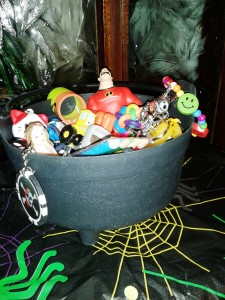
 Yesterday evening there was a knock on the front door. No one knocks on our front door, they always come in via the kitchen, so that was strange right away. I never receive unexpected callers either and everyone knows it, so I was more than surprised when the knocking continued and didn’t stop, and I was more than annoyed when the dogs didn’t bark at all. I hate to think of my dogs being cowed, so I ran to investigate and flung the door wide open. There on the other side of the threshold was an old, thin-looking woman with a gipsy ring on her outstretched hand and a hooky nose on her narrow face. Yet she wasn’t thin exactly, more wiry than anything, and she had big bones, and steely muscles, and if I thought she was thin I didn’t think she looked puny. Far from it. This was a formidable woman, you understand. Here! she said, and I stood my ground and said nothing because I was amazed and disconcerted. Here, she repeated. Here, you! Do you want your fortune reading! Now, for all that I would love to have my fortune read, I am afraid to see into the future, so I held out my hand in front of me and opened the palm in her face to show her what I thought of her question. The grim old woman didn’t speak again, but she stared through me and fixed her gaze on something behind me. She crooked a finger and beckoned it to come and when I turned I saw bears, dozens of bears, crawling along the tiled floor of the hall towards me (or rather towards her). Alleycat! I cried. Alleycat, where are you!
Yesterday evening there was a knock on the front door. No one knocks on our front door, they always come in via the kitchen, so that was strange right away. I never receive unexpected callers either and everyone knows it, so I was more than surprised when the knocking continued and didn’t stop, and I was more than annoyed when the dogs didn’t bark at all. I hate to think of my dogs being cowed, so I ran to investigate and flung the door wide open. There on the other side of the threshold was an old, thin-looking woman with a gipsy ring on her outstretched hand and a hooky nose on her narrow face. Yet she wasn’t thin exactly, more wiry than anything, and she had big bones, and steely muscles, and if I thought she was thin I didn’t think she looked puny. Far from it. This was a formidable woman, you understand. Here! she said, and I stood my ground and said nothing because I was amazed and disconcerted. Here, she repeated. Here, you! Do you want your fortune reading! Now, for all that I would love to have my fortune read, I am afraid to see into the future, so I held out my hand in front of me and opened the palm in her face to show her what I thought of her question. The grim old woman didn’t speak again, but she stared through me and fixed her gaze on something behind me. She crooked a finger and beckoned it to come and when I turned I saw bears, dozens of bears, crawling along the tiled floor of the hall towards me (or rather towards her). Alleycat! I cried. Alleycat, where are you!


By Mary Pleiss
 When I was a little girl, the witches I knew came from fairy tales. They were old, ugly, and mean–life ruiners who cast evil spells with no provocation. My young friends and I ran into the problem of the witch in our play. We didn’t want to meet a witch in a dark forest or a bright one, even if that forest was the pair of trees in our backyard. Certainly none of us wanted to be the witch. But we knew we had to have a witch. Witches made things happen, provided scary, shivery tension, and gave the good characters something to fight against and overcome.
When I was a little girl, the witches I knew came from fairy tales. They were old, ugly, and mean–life ruiners who cast evil spells with no provocation. My young friends and I ran into the problem of the witch in our play. We didn’t want to meet a witch in a dark forest or a bright one, even if that forest was the pair of trees in our backyard. Certainly none of us wanted to be the witch. But we knew we had to have a witch. Witches made things happen, provided scary, shivery tension, and gave the good characters something to fight against and overcome.
We often solved this problem by keeping the witch offscreen; we called out plot points detailing the unseen, unheard witch’s actions: “Now the witch is casting her spell. If you get to the swing set, you’re safe!” or, “You stepped into the witch’s clover patch–you’re trapped!” We could imagine the witch without casting her because we’d read stories and seen movies (mostly Disney movies and of course The Wizard of Oz). We knew witches well enough to weave them into our play without having to face the fact that we all had it in ourselves to be witches.
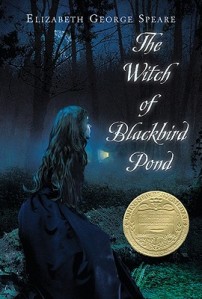 In sixth grade, I read Elizabeth George Speare’s The Witch of Blackbird Pond, and I started thinking about witches in a different way. What made the people of Wethersfield believe Hannah Tupper and Kit Tyler were witches, when any reader could see they weren’t magical or evil–just a little bit different? Why did their neighbors feel the need to banish or imprison them? If Hannah and Kit weren’t really evil, what did that say about the fairy tale witches I’d always feared and hated?
In sixth grade, I read Elizabeth George Speare’s The Witch of Blackbird Pond, and I started thinking about witches in a different way. What made the people of Wethersfield believe Hannah Tupper and Kit Tyler were witches, when any reader could see they weren’t magical or evil–just a little bit different? Why did their neighbors feel the need to banish or imprison them? If Hannah and Kit weren’t really evil, what did that say about the fairy tale witches I’d always feared and hated?
The witches in our fiction today are very different from those in fairy tales, and it turns out that even the Wicked Witch of the West has more complexity than I realized when I was growing up. I knew her from the movie, but reading the books as an adult, and learning more about the history of the Oz books in particular and witches–and those who were accused of witchcraft–in western culture has witches in a new light. L. Frank Baum was heavily influenced by his mother-in-law, Matilda Gage, who was an historian and feminist who promoted influential theories about women who were called witches in history. Baum had those theories in mind when he populated Oz with witches who were more dimensional than what had come before; they had backstories and motivations, and while some of them were evil, just as many were good.
Since Baum, of course, a number of children’s and YA writers have included witches–and women accused of witchcraft–in their stories. Whether bad, good, or somewhere in between, those witches have developed into characters with more depth and complexity than even Baum could have imagined. As societal attitudes about the roles of girls and women have evolved, fictional characterizations of witches have changed, and we can’t get away with taking the problematic witch offscreen or making her a one-dimensional villain. Now, when we write about witches, we work to make them as dimensional as all of our other characters, and our problem becomes the same as that we face with most other characters: how do we bring the witch to life?
Here are some suggestions and questions you can ask yourself if you’re including witchy characters in your fiction:
Consider doing some research into historical witches and witchcraft trials. You might find an angle or a detail no one’s ever written about before.
If your witches really do practice magic, is their power individual or communal, or some combination of both? Is magic learned or innate? Can you make witchcraft/magic a source of conflict, rather than a crutch that relieves it?
Does your character need to make choices about her “witchiness”—whether it’s to become a witch, to fully use or curtail her own power, or to educate herself about her power? Against or for whom she will use her power? Will she embrace her power right away, or resist it?
These are, of course, just a start to creating fully realized witch characters, but they’re a way to turn the witch into an integral part of your story, rather than a flat stereotype. Give your readers more to think about when you write witches, so that kids who play pretend will argue over who gets to be the witch, rather than relegating her to an offscreen ghost.
 Mary Pleiss: Though some might say all the hours Mary Pleiss spent haunting the library and disappearing into book worlds hinted at her future in writing for middle grade and young adult readers, she confesses that at the time she just thought it was a good way to escape her noisy family (she loves them, really, but six siblings can be a bit much at times). She is a curriculum development specialist, teacher, and recent graduate of Vermont College of Fine Arts, with an MFA in Writing for Children and Young Adults.
Mary Pleiss: Though some might say all the hours Mary Pleiss spent haunting the library and disappearing into book worlds hinted at her future in writing for middle grade and young adult readers, she confesses that at the time she just thought it was a good way to escape her noisy family (she loves them, really, but six siblings can be a bit much at times). She is a curriculum development specialist, teacher, and recent graduate of Vermont College of Fine Arts, with an MFA in Writing for Children and Young Adults.
Follow Mary on Twitter: @MKPleiss
This blog post was brought to you as part of the March Dystropian Madness blog series.


By Mary Pleiss
 When I was a little girl, the witches I knew came from fairy tales. They were old, ugly, and mean–life ruiners who cast evil spells with no provocation. My young friends and I ran into the problem of the witch in our play. We didn’t want to meet a witch in a dark forest or a bright one, even if that forest was the pair of trees in our backyard. Certainly none of us wanted to be the witch. But we knew we had to have a witch. Witches made things happen, provided scary, shivery tension, and gave the good characters something to fight against and overcome.
When I was a little girl, the witches I knew came from fairy tales. They were old, ugly, and mean–life ruiners who cast evil spells with no provocation. My young friends and I ran into the problem of the witch in our play. We didn’t want to meet a witch in a dark forest or a bright one, even if that forest was the pair of trees in our backyard. Certainly none of us wanted to be the witch. But we knew we had to have a witch. Witches made things happen, provided scary, shivery tension, and gave the good characters something to fight against and overcome.
We often solved this problem by keeping the witch offscreen; we called out plot points detailing the unseen, unheard witch’s actions: “Now the witch is casting her spell. If you get to the swing set, you’re safe!” or, “You stepped into the witch’s clover patch–you’re trapped!” We could imagine the witch without casting her because we’d read stories and seen movies (mostly Disney movies and of course The Wizard of Oz). We knew witches well enough to weave them into our play without having to face the fact that we all had it in ourselves to be witches.
 In sixth grade, I read Elizabeth George Speare’s The Witch of Blackbird Pond, and I started thinking about witches in a different way. What made the people of Wethersfield believe Hannah Tupper and Kit Tyler were witches, when any reader could see they weren’t magical or evil–just a little bit different? Why did their neighbors feel the need to banish or imprison them? If Hannah and Kit weren’t really evil, what did that say about the fairy tale witches I’d always feared and hated?
In sixth grade, I read Elizabeth George Speare’s The Witch of Blackbird Pond, and I started thinking about witches in a different way. What made the people of Wethersfield believe Hannah Tupper and Kit Tyler were witches, when any reader could see they weren’t magical or evil–just a little bit different? Why did their neighbors feel the need to banish or imprison them? If Hannah and Kit weren’t really evil, what did that say about the fairy tale witches I’d always feared and hated?
The witches in our fiction today are very different from those in fairy tales, and it turns out that even the Wicked Witch of the West has more complexity than I realized when I was growing up. I knew her from the movie, but reading the books as an adult, and learning more about the history of the Oz books in particular and witches–and those who were accused of witchcraft–in western culture has witches in a new light. L. Frank Baum was heavily influenced by his mother-in-law, Matilda Gage, who was an historian and feminist who promoted influential theories about women who were called witches in history. Baum had those theories in mind when he populated Oz with witches who were more dimensional than what had come before; they had backstories and motivations, and while some of them were evil, just as many were good.
Since Baum, of course, a number of children’s and YA writers have included witches–and women accused of witchcraft–in their stories. Whether bad, good, or somewhere in between, those witches have developed into characters with more depth and complexity than even Baum could have imagined. As societal attitudes about the roles of girls and women have evolved, fictional characterizations of witches have changed, and we can’t get away with taking the problematic witch offscreen or making her a one-dimensional villain. Now, when we write about witches, we work to make them as dimensional as all of our other characters, and our problem becomes the same as that we face with most other characters: how do we bring the witch to life?
Here are some suggestions and questions you can ask yourself if you’re including witchy characters in your fiction:
Consider doing some research into historical witches and witchcraft trials. You might find an angle or a detail no one’s ever written about before.
If your witches really do practice magic, is their power individual or communal, or some combination of both? Is magic learned or innate? Can you make witchcraft/magic a source of conflict, rather than a crutch that relieves it?
Does your character need to make choices about her “witchiness”—whether it’s to become a witch, to fully use or curtail her own power, or to educate herself about her power? Against or for whom she will use her power? Will she embrace her power right away, or resist it?
These are, of course, just a start to creating fully realized witch characters, but they’re a way to turn the witch into an integral part of your story, rather than a flat stereotype. Give your readers more to think about when you write witches, so that kids who play pretend will argue over who gets to be the witch, rather than relegating her to an offscreen ghost.
 Mary Pleiss: Though some might say all the hours Mary Pleiss spent haunting the library and disappearing into book worlds hinted at her future in writing for middle grade and young adult readers, she confesses that at the time she just thought it was a good way to escape her noisy family (she loves them, really, but six siblings can be a bit much at times). She is a curriculum development specialist, teacher, and recent graduate of Vermont College of Fine Arts, with an MFA in Writing for Children and Young Adults.
Mary Pleiss: Though some might say all the hours Mary Pleiss spent haunting the library and disappearing into book worlds hinted at her future in writing for middle grade and young adult readers, she confesses that at the time she just thought it was a good way to escape her noisy family (she loves them, really, but six siblings can be a bit much at times). She is a curriculum development specialist, teacher, and recent graduate of Vermont College of Fine Arts, with an MFA in Writing for Children and Young Adults.
Follow Mary on Twitter: @MKPleiss
This blog post was brought to you as part of the March Dystropian Madness blog series.



By:
Ellis Nadler,
on 3/15/2013
Blog:
Ellis Nadler's Sketchbook
(
Login to Add to MyJacketFlap)
JacketFlap tags:
cloud,
bird,
witch,
words,
death,
landscape,
Nadler,
hat,
moon,
sea,
iPad,
children,
food,
travel,
man,
tree,
drawing,
animals,
cartoon,
Add a tag
Four more new pages from my forthcoming
Memoirs.
Paper53 on iPad. Click to enlarge.

By:
Ellis Nadler,
on 3/13/2013
Blog:
Ellis Nadler's Sketchbook
(
Login to Add to MyJacketFlap)
JacketFlap tags:
food,
man,
drawing,
animals,
ink,
bird,
witch,
pen,
death,
mouth,
eye,
Nadler,
wash,
fruit,
sea,
nose,
brush,
unconscious,
iPad,
Add a tag
The
Tomato Witch bombs the Bishop and
Pinocchio at sea at midnight.
ZenBrush on iPad. Click to enlarge.

By:
Ellis Nadler,
on 2/20/2013
Blog:
Ellis Nadler's Sketchbook
(
Login to Add to MyJacketFlap)
JacketFlap tags:
people,
hair,
cartoon,
witch,
death,
graphite,
eye,
Nadler,
hat,
hand,
nose,
food,
drawing,
Add a tag
A group of Tomato Witches, A Blind Artist and a Blocked Writer, and a Dying Writer in bed. Three sketches for the Almussafes project and forthcoming exhibition.
Pencil with digital colour, various sizes but smallish. Click to enlarge.

By:
Ellis Nadler,
on 12/19/2012
Blog:
Ellis Nadler's Sketchbook
(
Login to Add to MyJacketFlap)
JacketFlap tags:
children,
food,
drawing,
animals,
cartoon,
bird,
witch,
eye,
Nadler,
hat,
hand,
fruit,
nose,
ear,
Add a tag
Every tomato I bite into lately seems to contain a witch.
Two more variants of Dream no.1 from the forthcoming
Almussafes book of Spanish children's dreams.
Click to enlarge.

By:
Ellis Nadler,
on 12/11/2012
Blog:
Ellis Nadler's Sketchbook
(
Login to Add to MyJacketFlap)
JacketFlap tags:
children,
food,
animals,
red,
bird,
witch,
death,
eye,
Nadler,
hand,
fruit,
print,
woodcut,
iPad,
Add a tag
I'm continuing my testing of the Ukiyo-e app on iPad as a proofing device prior to cutting actual wood blocks. The image is yet another
Tomato Witch for the
Almussafes series of Spanish children's dreams as collected by
Roger Omar.
Ukiyo-e on iPad. Click to enlarge.

By:
Ellis Nadler,
on 12/2/2012
Blog:
Ellis Nadler's Sketchbook
(
Login to Add to MyJacketFlap)
JacketFlap tags:
food,
woman,
animals,
red,
bird,
witch,
death,
Nadler,
hand,
blue,
fruit,
gouache,
Add a tag
Another take on the evil
tomato witch for the
Almussafes Book of Children's Dreams.
Gouache A3 size. Click to enlarge.
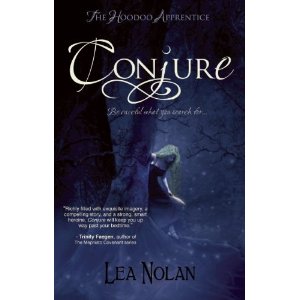
Conjure
by Lea Nolan
Published by Entangled Publishing
Book description:
Be careful what you search for…
Emma Guthrie expects this summer to be like any other in the South Carolina Lowcountry–hot and steamy with plenty of beach time alongside her best friend and secret crush, Cooper Beaumont, and Emma’s ever-present twin brother, Jack. But then a mysterious eighteenth-century message in a bottle surfaces, revealing a hidden pirate bounty. Lured by the adventure, the trio discovers the treasure and unwittingly unleashes an ancient Gullah curse that attacks Jack with the wicked flesh-eating Creep and promises to steal Cooper’s soul on his approaching sixteenth birthday.
When a strange girl appears, bent on revenge; demon dogs become a threat; and Jack turns into a walking skeleton; Emma has no choice but to learn hoodoo magic to undo the hex, all before summer—and her friends–are lost forever.
My thoughts:
Conjure is one of the most entertaining young adult novels I’ve read in a long time. It is a light, fun, and sometimes spooky read filled with sympathetic characters, intriguing hoodoo magic, and turns and twists that will keep you turning pages until the very satisfying ending–one that is open and hints at what will happen in book 2. That said, the novel pretty much stands on its own and only one problem is left unsolved.
Fifteen-year old Emma is an utterly likable character, strong, brave, sensitive, and forever loyal to her beloved twin brother, for whom she will go to he ends of the world for in order to save him from the terrible curse that threatens to destroy him. Her brother Jack is just as likable but very different from her; he’s quirky and quick-witted and at times impossible and selfish just like brothers usually are. The romance subplot between Emma and Jack’s best friend, Cooper, is sweet and refreshing and adds spice to the main story–not that it needs any extra spice. Plenty of dialogue make the pace move quickly and there’s lots of interesting information about hoodoo.
I usually dislike the use of flashbacks in a story but Nolan did a good job with them. I also enjoyed the Southern setting descriptions quite a lot; they certainly bring to life the South Carolina Lowcountry with its steamy, white-sand beaches and lush vegetation. Adult intrusion is kept to a bare minimum, so the story is centered around Emma, Jack, Cooper, the old hoodoo ‘witch’ who helps them and the mysterious beauty who has suddenly, out of nowhere, appeared in their lives and who has Jack mesmerized.
There are lots of exciting scenes in Conjure, especially when the teens are forced to bend the rules and cross the line for the higher good. Though there’s magic, witchcraft and curses involved, this isn’t a horror story and the tone is kept light throughout. There’s no bad language or sexy scenes either; Nolan keeps everything pretty sweet and proper. I certainly look forward to reading more from this talented YA author.
HUMBUG WITCH by Lorna Balian
ISBN 978-1-932065-32-9
32 pages, 6 1/2"x8 1/8", ages 4-8
Hardback, $12.95
Paperback available
This title is available in: English Spanish
Purchase from
Star Bright BooksWhat can a little witch do when her witchy spells and potions don't turn out right? She just keeps on trying... until it's time for bed.
My thoughts:This is an ADORABLY CUTE picture book! It kept a smile on my face all the way to the very satisfying, surprising ending. A pity my daughter is already a teenager. I know she would have loved it and asked me to read it to her again and again if she were younger.
Our little witch has everything a horrible, witchy witch should have, from her pointed black hat to her long stringy hair to her ugly black shoes with gold buckles, and more. But the problem is, no matter how hard she tries, she can't get her magic to work. She can't make her broom move an inch; she can't turn her car Fred into an alligator; she can't even make her magic potion to explode. What else is there to do? Well, she starts taking off all her witchy items one by one, until it's time for bed and we realize our witch isn't really a real witch but a little girl who's been playing all along.
Young children 4 to 8 will surely love this story that teaches simple vocabulary and sequencing. They will also have fun identifying the various 'witchy' objects on the page. With Halloween just around the corner, this is the perfect picture book to give to your child as a holiday gift. The illustrations are cute and whimsical and full of Halloween colors. Highly recommended.
Disclaimer: I was provided this review copy by the publisher via NetGalley.com. This is my honest opinion and I didn't receive any financial compensation.

By:
Roberta Baird,
on 10/5/2012
Blog:
A Mouse in the House
(
Login to Add to MyJacketFlap)
JacketFlap tags:
illustration,
Halloween,
Illustration Friday,
IF,
children's illustration,
Texas,
witch,
holiday,
digital art,
roberta baird,
artwork,
mirror,
houston,
a mouse in the house,
Ghoulies Roberta Baird,
dummy book,
www.robertabaird.com,
Add a tag
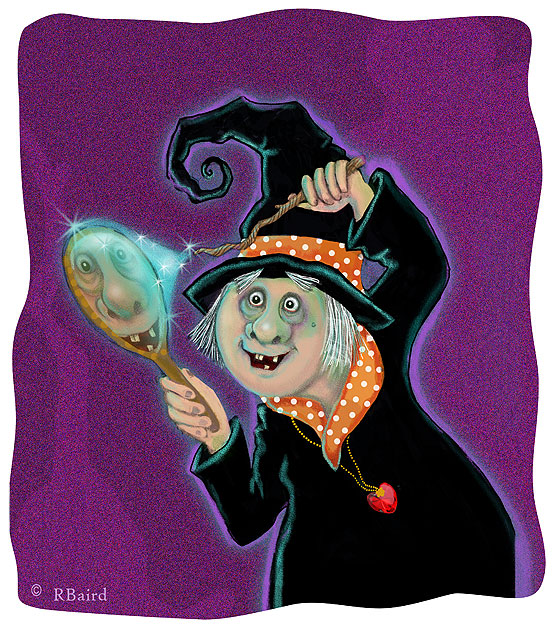
Ruby Rue was beautiful of heart
Though her outward appearance gave town folks a start
Her dreams of a suitor had not yet come true
With just internal beauty, what’s a poor hag to do?
So she consulted her Grimoire and found a grand hex
She enchanted a stone and hung it round her neck
Then she squealed to the mirror “Why Ruby… You’re hot!”
But her stone, it was faulty, for to others… she was not!
The lesson to garner, so you won’t be alone…
Keep your hope in your heart and not in a stone.
by
Roberta Baird


By:
Roberta Baird,
on 9/28/2012
Blog:
A Mouse in the House
(
Login to Add to MyJacketFlap)
JacketFlap tags:
illustration,
book,
Illustration Friday,
IF,
children's illustration,
witch,
digital art,
roberta baird,
artwork,
houston,
a mouse in the house,
children's book art,
Dummy Book,
www.robertabaird.com,
Add a tag
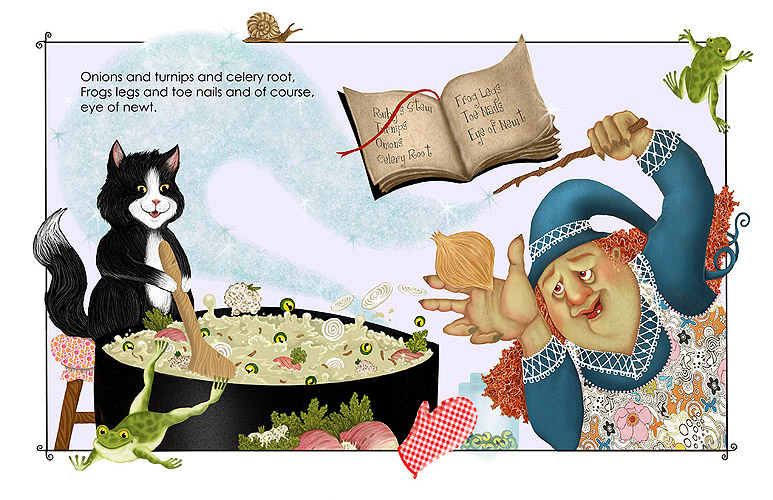 Ruby Rue had magnificent stew though her secret ingredient nobody knew.
Ruby Rue had magnificent stew though her secret ingredient nobody knew.

There's an evil witch in my ketchup. From a child's dream recorded in Almusaffes, Spain by
Roger Omar.Gouache and ink A3 size. Click to enlarge.
Illustration
Illustration Friday-Scary
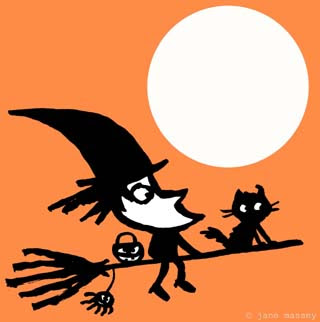
Happy Halloweeeen!
I hope you get lots of treats!
Here is a less scary Halloween witch from 2010.
I did a revamp of my website and blog this week. I didn’t initially intend to make a thematic (Halloween!) banner, but the idea to take this little witch that I created last year and remake it into a banner came to mind and I like how it turned out. Now my thoughts are on doing that consistently throughout the year. I have done that in the past, but maybe I’ll return to that. It could be fun.
So the new banner is below (and, of course, above).

Below is the initial illustration I reworked the banner from. To the right is a similar little witch that I did for our IFK promo postcard last fall. I still dig the style and all.

View Next 25 Posts

























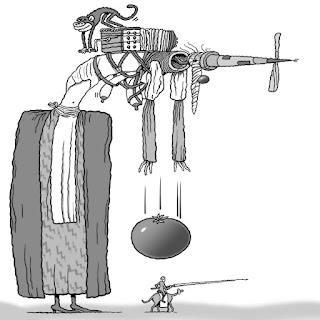




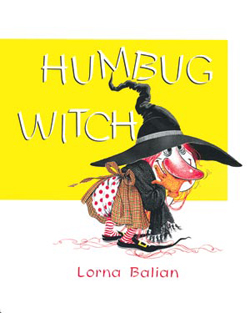






As I saw the picture I knew why they called this pland “Bearwind”, but I always thought it looks different LOL